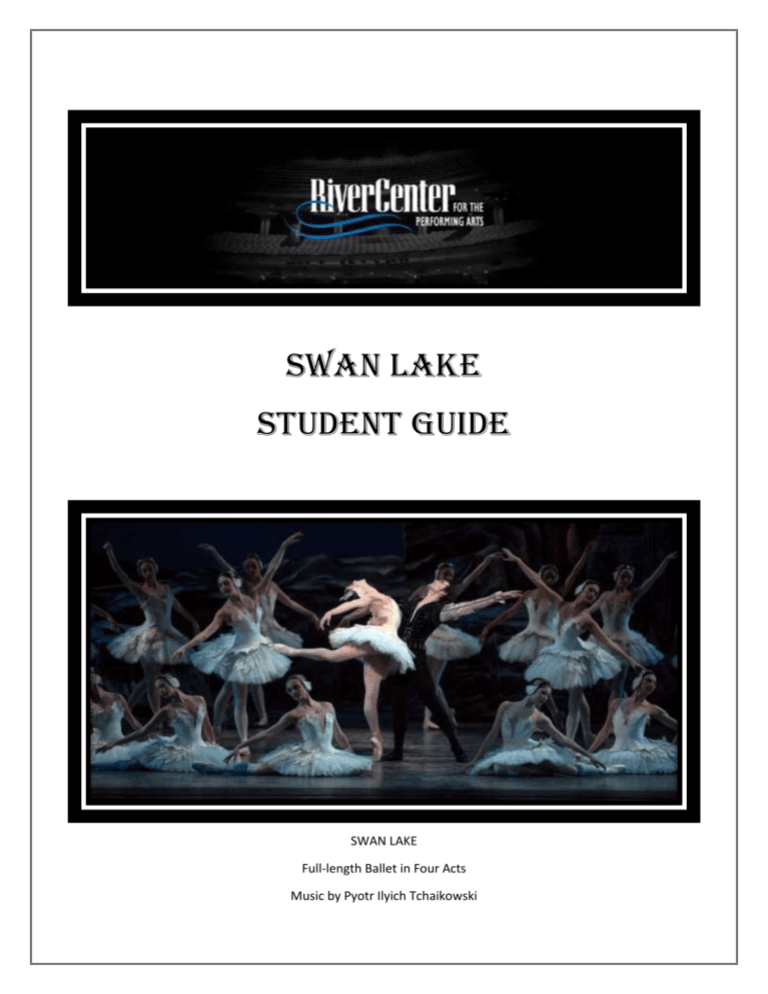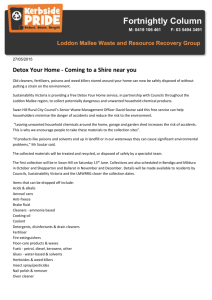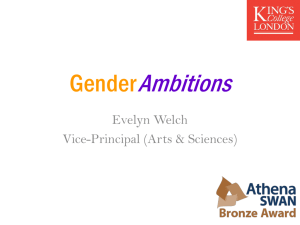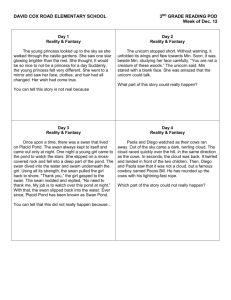SwanLake study guide
advertisement

Swan Lake Student Guide SWAN LAKE Full-length Ballet in Four Acts Music by Pyotr Ilyich Tchaikowski Choreography by Marius Petipa and Lev Ivanov Premiere: March 4, 1877 Bolshoi Theatre, Moscow ACT I The Garden of Prince Siegfried's Castle ACT II A Lakeside --Intermission-- ACT III The Great Hall of Siegfried’s Castle ACT IV The Lakeside ______________________________________________________________________________ PROGRAM NOTES ACT I The Garden of Prince Siegfried's Castle Prince Siegfried has come of age and entered upon a new world of affairs of war and the burdens of manhood. It is the day for leaving behind the whims and caprice of youth. A happy day for the Prince, though touched by anxiety. The kindly jester and tutor who have been the Prince's loving companions since his childhood are the first to congratulate him. He greets his companions and joyfully accepts the congratulations of all the residents of the Castle. The Prince's subjects come from far and wide to take part in the festivities. They confer upon him the sword and scepter of authority and swear allegiance to their new ruler. His mother, the Queen Mother of the Realm, presents him with an arbalest as a gift and reminds him that the time has come to choose a bride and that he must make the fateful decision at tomorrow’s ball. He is eager to contemplate this life change in silence. The festivities continue, but the Prince is overcome by a desire to be alone, far from his guests. As he begins to search the contents of his heart he notices a flight of white swans heading toward the nearby lake. He is inspired and follows them there, disappearing into the night. ACT II A Lakeside The voyage to the lake takes the Prince into the depths of the forest. He approaches the Swans quietly and as he nears he sees something quite out of the ordinary. The Swans have stepped ashore and assumed human form! Siegfried lowers the crossbow, astonished with their striking beauty. He gathers his courage and reveals himself. Odette, the swan’s Queen tells him of their terrible curse. They are all at the mercy of the wicked sorcerer Rotbart and only by finding true love can the evil spell be lifted. Siegfried, overcome with love at first sight, swears to her an everlasting love. As the sun beings to dawn, Odette warns him that if he breaks his oath, nothing will be able to help them. The Prince is completely overcome by the incomparable and exquisite delicacy of Odette, and swears that he will return and free her from the evil spell. As the sunlight touches them, the women transform back into Swans, cloaked in silence. --Intermission-ACT III The Great Hall of Prince Siegfried's Castle The castle resounds to the clamor of festivities. Renowned Princesses from Hungary, Russia, Spain, Italy and Poland are presented to the Prince. He must choose one of them as his bride, in order to strengthen his authority and consolidate his power. However, in none of these royal heiresses does he find a maiden comparable to Odette, to whom he has given his heart. He rejects them all. With an overwhelming blare of trumpets, a couple of new guests are announced. The evil sorcerer, Rotbart, enters in the guise of a noble knight, and following close behind is his daughter, Odylle, who looks remarkably like Odette. The similarity is so close, in fact, that Siegfried believes, if only for a split second, that it is Odette standing there before him. Odylle seizes the brief moment of illusion as an opportunity and will not allow him to find his senses. She becomes a bewitching temptress, luring him, hypnotizing him, and tricking him into confessing his undying love to her! In this hypnotic stupor, he proclaims that Odylle is to be his bride. Rotbard has triumphed! Siegfried has broken his oath to Odette, betraying her by professing love to another, thereby dooming Odette and the others to an eternity under Rotbart’s evil power. Suddenly a vision of the Swan Lake appears before Siegfried’s eyes, snapping him back into reality. He realizes the terrible mistake he has made. In despair he leaves the palace and hurries to Odette at the Lake. ACT IV The Lakeside Night falls again on the Lake. The swan maidens are anxious, for if the Prince does not fulfill his vow to set them free, they will be doomed to everlasting captivity. The sorcerer raises a raging storm to conceal the Swan Lake behind a screen of dark clouds, But the Prince rushes headlong through the storm to Odette. The sorcerer attempts to conceal her from him, but no power can stop the young man whose heart is so full of love. The Prince overcomes all obstacles, and the spell cast by the evil sorcerer is dashed forever on the rock of true love. HISTORY OF SWAN LAKE: THE STORY The story of Swan Lake includes ideas and themes found in several age-old tales and myths. The idea of bird-women and the theme of our search for enduring love are two such concepts to look at. Swans in Greek mythology were connected to wisdom and creativity and were associated with the Nine Muses. The beautiful voice of the half-bird half-woman Siren in Greek mythology could woo men off their course. Hindu’s swan-maiden goddess Saraswati, whose name means “one who flows,” is linked to purity, beauty, and the arts and is dressed in pure white. And closer to home, in Native American culture, the famous Sacagawea’s name means Bird-Maiden. At the time of Swan Lake people would have known of the Tales of the Thousand and One Nights, in which there is an account of Hasan of Basra, who visits the place of the bird-maidens. When they take off their feather garments, they become beautiful women. They might also have known the Russian story by Alexandre Pushkin, Tzar Sultan, which is the story of a prince who saves the life of a wounded swan who later reappears as a woman to marry him, and as well the German folktale by Hans Christian Andersen called The Wild Swans. Peter Ilyich Tchaikovsky, the composer of the music for Swan Lake, was likely influenced by Wagner’s opera Lohengrin, the story of a heroic Swan Prince, a man with a mysterious past who arrives on a magical swanboat. Because threads of these historical tales touch on universal experiences of longing for true love and the consequences of our actions, Swan Lake strikes a note of familiarity in the viewer even though it is a fantasy ballet.People have long marked their lives in seven year increments—by age seven one’s permanent teeth are in and toddler-hood is over, by fourteen adolescence is in full swing, and the 21st birthday is seen as a rite of passage to adulthood. The SPS audience will see Act III of Swan Lake. The act opens with a royal party comprised of guests from other lands gathered to celebrate an important event—a coming of age party honoring Prince Siegfried and the moment he will choose his bride. Lesson Plans: Ask students how 21st birthdays are celebrated in the 21st century in America or around the world? For Prince Siegfried it signified the end of his carefree days as a bachelor. Being 21 meant that he would need to choose a girl to marry whether he loved her or not and take on the responsibilities of an adult man. Ask how it might feel to be told by parents that this was what you must do? Students might research other cultures’ marriage traditions. Celebrations of all types have long included everyday people dancing together as well as professional entertainers performing dances. Recently the United States held an Inaugural Ball in honor of President Barak Obama. People from all over the world were invited, from dignitaries to high school marching bands. At one point President Obama and First Lady Michelle Obama danced together on stage. Why do we dance together at celebrations? Why do performers dance for us at celebrations? In Swan Lake Act III the stage lighting makes a dramatic shift when Von Rothbart in his dark flowing cape and his daughter Odile dressed as the Black Swan enter. Ask students to watch for their entrance. Suggest that after the performance you will discuss what happened and how they felt at that moment. SWAN LAKE is a classical ballet that combines real world situations with fantasy. In its entirety it has four acts and is three hours long. Acts I and III occur in the royal court of a Queen and her son Prince Siegfried, Acts II and IV occur near a lake where maidens are trapped in an evil sorcerer’s spell and must live as swans by day and women at night. SWAN LAKE: THE MUSIC The story of Swan Lake appealed to Tchaikovsky’s romantic nature. He had previously composed a little ballet for his niece and nephew in 1871 called The Lake of the Swans. He brought the musical theme, or leitmotif, that represents the Swan Queen from that earlier family entertainment into his composition for Swan Lake. A leitmotif (pronounced light-mow-teef) is a musical theme that recurs to evoke a particular feeling related to a character or situation or to signal that the character is present. A leitmotif is often the melody that you hum in your head when you leave the performance. Listen to a recording of Swan Lake by Peter Ilyich Tchaikovsky. Ask students if the music feels “danceable.” See if they can identify any recurring melodies. Ask if they prefer one section more than another. Folk dances from countries around the world consist of locomotor movements (steps that travel from one place to another) and non-locomotor movements done in place. Usually there is a repeatable pattern of moves that matches the beat of the music. Sometimes the dances are done in certain formations, like a circle or a square. The Kennedy Center has a wonderful website, ArtsEdge, that provides resources and lesson plans for teachers. Here are links to two approaches to folk dances, one for early elementary and the other for Grades 5-8. http://artsedge.kennedy-center.org/educators/how-to/tipsheets/early-elementary-social-dance.aspx http://artsedge.kennedy-center.org/educators/standards/national/arts-standards/5-8/dance/dance-5.aspx Former Principal Dancer Anne Mueller and former Soloist Steven Houser. Photo by Ben Kerns. Here is a listing of dance segments from the Stage Manager’s cue notes outlining the events of Act III MARCH PAS DE TROIS PRINCESSES VON ROTHBART & ODILE ENTER SPANISH NEOPOLITAN RUSSIAN CZARDAS (HUNGARIAN) BLACK SWAN PAS DE DEUX DECEPTION IS DISCOVERED Act III includes several dances inspired by traditional folk dances that hail from European countries— Spain, Italy, Russia, and Hungary. Each time a choreographer embarks on creating Swan Lake, they must decide whether to follow a tradition or create something new. View and compare two youtube videos of the Russian dance: one a solo, the other a pas de deux http://www.youtube.com/watch?v=mJTNaZKbaYs http://www.youtube.com/watch?v=p1-cC7kW7iA View American Ballet Theatre’s Czardas (Hungarian) folk dance and compare to Polish folk dance by students in San Diego http://www.youtube.com/watch?v=u5B641myoMQ http://www.youtube.com/watch?v=vExHWiJ8OoQ Folk dances keep evolving. Check out the amazing skills in Romafest Gypsy Dance Theater’s, Rhythm Game. http://www.youtube.com/watch?v=N2dMk-vMWS8 Check out this link to OBT’s blog and look at videos about Swan Lake. http://oregonballettheatre.wordpress.com/2013/01/23/ RUSSIAN NATIONAL BALLET THEATRE Artistic Director: Elena Radchenko The Russian National Ballet Theatre was founded in Moscow during the transitional period of Perestroika in the late 1980s, when many of the great dancers and choreographers of the Soviet Union's ballet institutions were exercising their new-found creative freedom by starting new, vibrant companies dedicated not only to the timeless tradition of classical Russian Ballet but to invigorate this tradition as the Russians began to accept new developments in the dance from around the world. The company, then titled the Soviet National Ballet, was founded by and incorporated graduates from the great Russian choreographic schools of Moscow, St. Petersburg and Perm. The principal dancers of the company came from the upper ranks of the great ballet companies and academies of Russia, and the companies of Riga, Kiev and even Warsaw. Today, the Russian National Ballet Theatre is its own institution, with over 50 dancers of singular instruction and vast experience, many of whom have been with the company since its inception. In addition to their upcoming tour, beginning in January 2011 the company will embark upon a 4-month coast-to-coast tour of the United States. In 1994, the legendary Bolshoi principal dancer Elena Radchenko was selected by Presidential decree to assume the first permanent artistic directorship of the company. Ms. Radchenko is the founder of the Russian National Ballet Theatre, and she has focused the Company on upholding the grand national tradition of the major Russian ballet works and developing new talents throughout Russia, with a repertory of virtually all of the great full works of Petipa: Don Quixote, La Bayadere, The Sleeping Beauty, Swan Lake, Raymonda, Paquita, Coppelia and La Sylphide, as well as productions of, among others, The Nutcracker, Sylvia, and La Fille Mal Gardee. Pre-performance Activities: Swan Lake: The Game Show After sharing the history and story of Swan Lake with your students, ask questions in a game show style format. This can be a fun way to check for understanding and will help prepare students for what they will experience at the theater. Tip: Little prizes can be fun to add to this activity. Here are 8 questions to start with. You may come up with your own or have students participate in creating the questions. Questions 1. Who is the choreographer of the version of Swan Lake you will see at Cal Performances? 2. Who is the composer of the score for Swan Lake? 3. What vow did Siegfried break with Odette? 4. Who originally choreographed Swan Lake? 6. What was the name of the ballet company you saw perform in Zellerbach Hall? 7. Who is the artistic director of the ballet company? 8. What helped you understand the story even though there were no words? Discussion of Common Themes Many of the stories that ballets are based on have similiar themes. For example good and evil, or love and betrayal. Select other fairytales to read outloud to your students. Afterwards, have students brainstorm common themes. Ask students to see whether they recognize any of the same themes when they see the performance of Swan Lake. Classic Romantic Ballets: Characteristics to look for: • Supernatural elements like fairies, magicians and mythical creatures • Stories of tragic love • Tutus for women (either short or mid length) • Pantomine used to communicate emotion or action Post Performance Activities Performance Summary Consider the following questions when writing your summary of the performance: Costumes: What colors were used for the dancers’ costumes? How did the costumes add to the overallperformance? Dances and Movement: Did the men and women move differently? Pick one of the dances you enjoyed most and explain what the dance was about and describe how the dancers moved. Performance Poster Now that you have seen Swan Lake, your assignment is to make a poster advertising the performance. Consider the following while designing your poster: What words will you choose to put on the poster that will inform the public about this group? What graphics will you use? How does color communicate feeling or set a tone? What information do you need to include? Think about time, location, date etc. How will youemphasize this information. Works Cited Pre and Post Show questions: Gruener, K. (n.d.). Swan Lake Study Guide . . Retrieved July 10, 2014, from http://www.obt.org/outreach_links/SPS_SwanLake_StudyGuide.pdf









